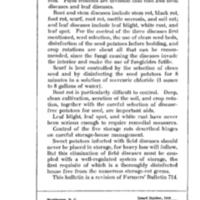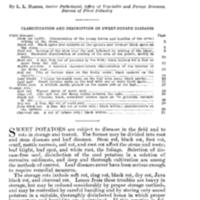Sweet-Potato Diseases
Creator
Date
1928
Excerpt
DISEASES of sweet potatoes are divisible into two classes, (1) field troubles and (2) storage rots. Field troubles are divisible into root and stem diseases and leaf diseases.
Root and stem diseases include stem rot, black rot, foot rot, scurf, root rot, mottle necrosis, and soil rot; and leaf diseases include leaf blight, white rust, and leaf spot. For the control of the three diseases first mentioned, seed selection, the use of clean seed beds, disinfection of the seed potatoes before bedding, and crop rotations are about all that can be recommended, since the fungi causing the diseases invade the interior and make the use of fungicides futile.
Scurf is best controlled by the selection of clean seed and by disinfecting the seed potatoes for 8 minutes in a solution of mercuric chloride (1 ounce to 8 gallons of water).
Root rot is particularly difficult to control. Deep, clean cultivation, aeration of the soil, and crop rotation, together with the careful selection of disease-free potatoes for seed, are important aids.
Leaf blight, leaf spot, and white rust have never been serious enough to require remedial measures.
Control of the five storage rots described hinges on careful storage-house management.
Sweet potatoes infected with field diseases should never be placed in storage, for heavy loss will follow. But this elimination of field diseases must be coupled with a well-regulated system of storage, the first requisite of which is a thoroughly disinfected house free from the numerous storage-rot germs.
This bulletin is a revision of Farmers' Bulletin 714.
Root and stem diseases include stem rot, black rot, foot rot, scurf, root rot, mottle necrosis, and soil rot; and leaf diseases include leaf blight, white rust, and leaf spot. For the control of the three diseases first mentioned, seed selection, the use of clean seed beds, disinfection of the seed potatoes before bedding, and crop rotations are about all that can be recommended, since the fungi causing the diseases invade the interior and make the use of fungicides futile.
Scurf is best controlled by the selection of clean seed and by disinfecting the seed potatoes for 8 minutes in a solution of mercuric chloride (1 ounce to 8 gallons of water).
Root rot is particularly difficult to control. Deep, clean cultivation, aeration of the soil, and crop rotation, together with the careful selection of disease-free potatoes for seed, are important aids.
Leaf blight, leaf spot, and white rust have never been serious enough to require remedial measures.
Control of the five storage rots described hinges on careful storage-house management.
Sweet potatoes infected with field diseases should never be placed in storage, for heavy loss will follow. But this elimination of field diseases must be coupled with a well-regulated system of storage, the first requisite of which is a thoroughly disinfected house free from the numerous storage-rot germs.
This bulletin is a revision of Farmers' Bulletin 714.
Title
Sweet-Potato Diseases
File(s)
Sweet-Potato Diseases cover.jpg
(image/jpeg)
Sweet-Potato Diseases introduction.jpg
(image/jpeg)
Sweet-Potato Diseases TOC.jpg
(image/jpeg)
 An official website of the United States government.
An official website of the United States government.




